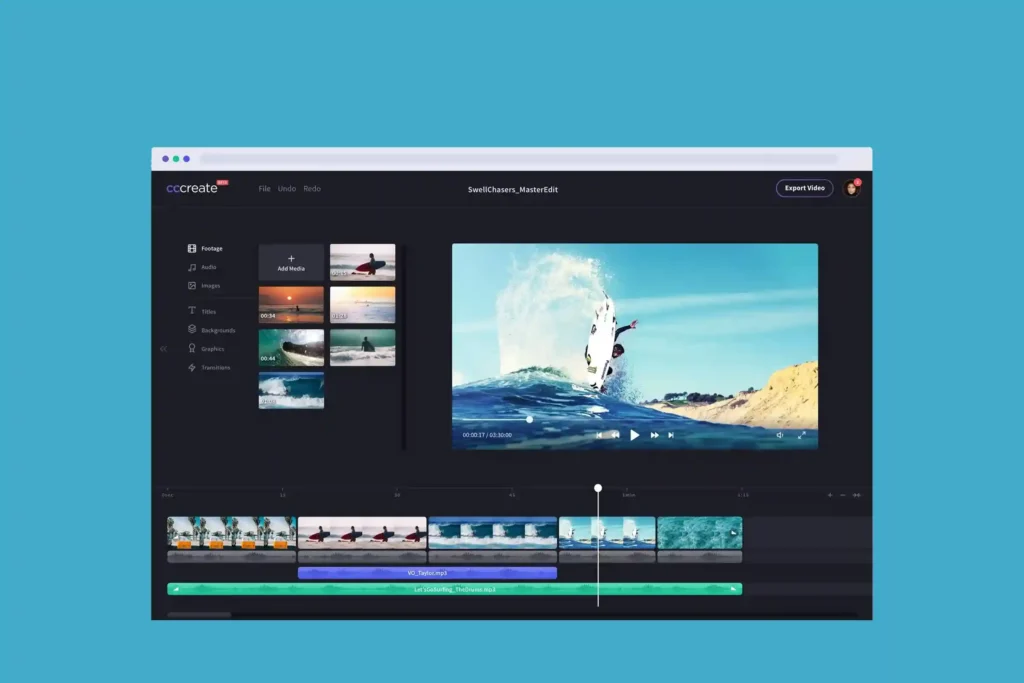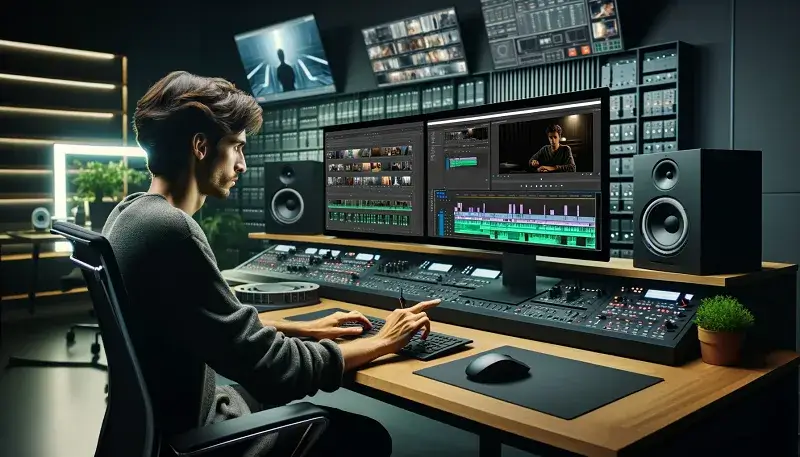Video editing is fun and creative. You can make any video look professional with the right skills. This guide teaches you everything about mastering video editing. You will learn basic cuts to advanced effects.
What is Video Editing?

Video editing means changing raw footage into a finished video. You cut bad parts, add music and effects, make colors look better. You put everything together to tell a story.
Video editing helps you:
- Make boring videos exciting
- Fix problems in your footage
- Add music and sound effects
- Create smooth scene changes
- Tell better stories
- Keep viewers watching longer
Basic Video Editing Terms
Learn these simple words first:
- Cut: Remove a piece of video
- Trim: Make a clip shorter
- Splice: Join two clips together
- Timeline: Where you arrange your clips
- Track: A layer for video or audio
- Render: Create the final video file
Getting Started with Video Editing
What You Need
Your computer needs enough power for video work. Slow computers make editing frustrating. Here are the basic needs:
Computer Requirements:
- Fast processor: Intel i5 or AMD Ryzen 5 minimum
- Lots of memory: 16GB RAM to start
- Good graphics card: Helps videos play smoothly
- Fast hard drive: SSD drives work best
- Big screen: See details clearly while editing
- Good speakers: Hear audio problems easily
Storage Tips:
- Keep project files organized
- Make backup copies of everything
- Use clear file names
- Group similar clips together
- Save work often
- Delete old projects to save space
Choosing Video Editing Software
The right software makes mastering video editing easier. Different programs work for different needs and budgets.
Free Video Editing Programs
You can start learning without spending money. These free programs work well for beginners:
Best Free Options:
- DaVinci Resolve: Professional features for free
- CapCut: Easy to use on phone and computer
- HitFilm Express: Good for adding special effects
- OpenShot: Simple and straightforward
- iMovie: Perfect for Mac users
- Windows Video Editor: Basic editing on PC
Why Free Software Works:
- Learn basics without cost
- Try different programs easily
- Upgrade later when ready
- Practice with real tools
- Build skills before investing
- Test what you like best
Paid Video Editing Software
Professional programs cost money but offer more features. They work faster and have better tools.
Top Professional Programs:
- Adobe Premiere Pro: Used by most professionals
- Final Cut Pro: Fast and powerful for Mac
- Avid Media Composer: Standard for movies and TV
- Adobe After Effects: Best for motion graphics
- Filmora: Good balance of features and ease
- Vegas Pro: Affordable professional option
Benefits of Paid Software:
- More editing tools available
- Better customer support
- Regular updates and improvements
- Professional file format support
- Advanced color and audio tools
- Team collaboration features
Basic Video Editing Skills
Cutting and Trimming
Good cutting makes videos flow smoothly. Learn to find the best moments in your footage. Remove parts that slow down your story.
Cutting Techniques:
- Simple cut: Change from one clip to another
- J-cut: Keep audio while changing video
- L-cut: Keep video while changing audio
- Jump cut: Skip forward in time quickly
- Match cut: Connect similar shapes or movements
- Cutaway: Show something related to main action
When to Make Cuts:
- Remove mistakes and bad parts
- Change camera angles for interest
- Follow the rhythm of music
- Show reactions and responses
- Build excitement and tension
- Keep viewers engaged
Working with Your Timeline
The timeline shows all your clips in order. Good timeline organization saves time and prevents mistakes.
Timeline Organization:
- Put video clips on top tracks
- Place audio on separate tracks
- Use different tracks for music and effects
- Label tracks clearly
- Color code similar clips
- Keep timeline clean and simple
Making Colors Look Amazing
Color work makes videos look professional. You can fix problems and create moods with color changes.
Basic Color Correction
Fix color problems first before making creative changes. Good color correction makes footage look natural and consistent.
Common Color Problems:
- Too dark or too bright
- Wrong white balance (too blue or orange)
- Flat contrast
- Weird skin tones
- Different colors between clips
- Overexposed or underexposed areas
Color Correction Steps:
- Fix exposure first
- Balance white levels
- Adjust contrast and shadows
- Match colors between clips
- Check skin tones look natural
- Make final small adjustments
Creative Color Grading
Color grading adds style and mood to your videos. It makes ordinary footage look cinematic and professional.
Popular Color Styles:
- Warm and cozy: Orange and yellow tones
- Cool and modern: Blue and teal colors
- Vintage look: Faded colors with film grain
- High contrast: Bold darks and bright lights
- Cinematic style: Orange skin, blue shadows
- Natural enhancement: Subtle improvements only
Creating Mood with Color:
- Bright colors for happy scenes
- Dark colors for serious moments
- Warm colors for comfort and love
- Cool colors for tension and sadness
- Saturated colors for energy and excitement
- Desaturated colors for dramatic effect
Audio Editing Basics
Good audio keeps people watching your videos. Bad audio makes viewers leave quickly. Learn to make your audio sound clear and professional.
Fixing Audio Problems
Most footage has audio issues that need fixing. Learn to identify and solve common problems.
Common Audio Issues:
- Background noise and hiss
- Voices too quiet or too loud
- Echo and room reverb
- Wind noise in outdoor recordings
- Different audio levels between clips
- Sync problems with video
Audio Repair Techniques:
- Remove background noise carefully
- Balance voice levels between clips
- Reduce echo with special filters
- Cut out breathing and mouth sounds
- Sync audio with video properly
- Add room tone for smooth transitions
Adding Music and Effects
Music and sound effects bring videos to life. They guide emotions and support your story.
Music Selection Tips:
- Choose music that fits your story mood
- Keep music volume lower than voices
- Use fade-ins and fade-outs for smooth transitions
- Match music tempo to video pace
- Avoid copyrighted music for online videos
- Cut music to match video length
Sound Effects Usage:
- Add natural sounds for realism
- Use effects to emphasize actions
- Layer multiple sounds for richness
- Keep effects volume balanced
- Time effects precisely with visuals
- Create atmosphere with ambient sounds
Advanced Editing Techniques
Smooth Transitions
Transitions connect your clips together. Good transitions feel natural and help tell your story better.
Basic Transition Types:
- Straight cut: Quick change between clips
- Fade to black: Slow disappear and appear
- Cross dissolve: One clip fades into another
- Slide: One clip pushes another away
- Wipe: New clip reveals from one direction
- Zoom: Scale between different shot sizes
Creative Transition Ideas:
- Use moving objects to hide cuts
- Match similar colors between clips
- Follow action across cuts
- Use light flashes as transition points
- Create rhythm with music beats
- Hide cuts with camera movements
Adding Text and Graphics
Text and graphics give information and style to your videos. They help viewers understand your content better.
Text Types:
- Titles: Video and section names
- Lower thirds: Names and information
- Captions: What people are saying
- Call-outs: Point out important details
- End credits: Thank people and show contact info
- Social media tags: Handles and hashtags
Text Design Tips:
- Keep text simple and readable
- Use colors that stand out from background
- Make text large enough to read easily
- Don’t put too much text on screen
- Time text to appear and disappear smoothly
- Use consistent fonts throughout video
Different Types of Video Projects
Social Media Videos
Each platform needs different video styles. Learn what works best for each one.
YouTube Videos:
- Make strong openings to hook viewers
- Create interesting thumbnails
- Keep good pacing throughout
- Add end screens for more views
- Use chapters for long videos
- Optimize titles and descriptions
Short Videos (TikTok, Instagram Reels):
- Start with attention-grabbing moments
- Use vertical format (9:16 ratio)
- Keep cuts fast and energetic
- Add trending music and sounds
- Include text overlays for context
- Make videos that loop smoothly
Facebook and Instagram Posts:
- Create square format versions
- Add captions for silent viewing
- Keep important action in center
- Use bright, eye-catching visuals
- Make first few seconds compelling
- Include clear calls to action
Professional Video Projects
Business and professional videos need different approaches than social media content.
Corporate Videos:
- Keep style clean and professional
- Use company colors and branding
- Include clear messages and information
- Make sure audio is perfect
- Follow brand guidelines strictly
- Create multiple versions for different uses
Educational Content:
- Break complex topics into simple parts
- Use visual examples and demonstrations
- Add clear narration and explanations
- Include helpful graphics and charts
- Maintain steady pacing for learning
- Provide summaries and key points
Technical Tips for Better Results
File Management
Good file organization saves time and prevents lost work. Set up systems before you start editing.
Organization System:
- Create folders for each project
- Separate raw footage from edited versions
- Name files with dates and descriptions
- Keep all project assets in one place
- Back up important files regularly
- Delete old projects to save space
File Format Guidelines:
- Use MP4 for web and social media
- Keep original files for future edits
- Export different sizes for different platforms
- Test videos on target devices
- Compress files appropriately for use
- Save master copies uncompressed
Computer Performance
Make your computer run editing software smoothly. Slow performance ruins creativity and wastes time.
Speed Improvement Tips:
- Close other programs while editing
- Use proxy files for large videos
- Clear cache files regularly
- Add more memory if possible
- Use fast external drives
- Restart computer between long sessions
Workspace Setup:
- Use two monitors if available
- Learn keyboard shortcuts for speed
- Organize editing panels efficiently
- Set up comfortable seating and lighting
- Keep workspace clean and organized
- Have good speakers or headphones ready
Quality vs File Size
Balance video quality with file size needs. Bigger files look better but take longer to upload and download.
Compression Guidelines:
- Use higher quality for important projects
- Compress more for quick social media posts
- Test different settings to find sweet spot
- Consider viewer internet speed
- Match quality to viewing device
- Save uncompressed master copies
Common Mistakes to Avoid
Beginner Editing Mistakes
New editors often make the same mistakes. Learn what to avoid from the start.
Technical Mistakes:
- Not organizing files properly
- Forgetting to save work frequently
- Using too many effects and transitions
- Ignoring audio quality completely
- Exporting with wrong settings
- Not backing up project files
Creative Mistakes:
- Making cuts too fast or too slow
- Using music that doesn’t fit the mood
- Adding text that’s hard to read
- Keeping boring parts in the video
- Not thinking about the audience
- Copying other creators exactly
How to Fix Common Problems
When things go wrong, don’t panic. Most problems have simple solutions.
Problem-Solving Steps:
- Save your work before trying fixes
- Check if problem affects whole project
- Try restarting the software
- Look for simple setting changes first
- Ask for help in editing communities
- Keep backup copies of working versions
Building Your Skills
Practice Projects
The best way to improve is by editing different types of videos. Each project teaches new skills.
Good Practice Ideas:
- Edit family vacation videos
- Create music videos with your favorite songs
- Make short documentary about local topics
- Edit cooking or tutorial videos
- Create promotional videos for local businesses
- Make highlight reels from sports footage
Skill Development Path:
- Start with simple cuts and basic audio
- Add simple transitions and text
- Learn color correction basics
- Practice with different music styles
- Try special effects gradually
- Work on longer, complex projects
Learning Resources
Many free resources help you improve your editing skills. Use multiple sources to learn faster.
Where to Learn:
- YouTube tutorials: Free lessons on specific techniques
- Online courses: Structured learning programs
- Editing communities: Get feedback on your work
- Software documentation: Learn program-specific features
- Practice challenges: Timed editing exercises
- Collaboration projects: Work with other creators
Learning Tips:
- Watch tutorials while practicing
- Take notes on new techniques
- Practice same technique multiple times
- Ask questions in communities
- Share work for honest feedback
- Study videos you admire
Working with Different Camera Types
Phone Video Editing
Phone cameras create good quality videos now. Learn to edit phone footage effectively for best results.
Phone Footage Considerations:
- Usually shot in vertical format
- May have shaky camera movement
- Audio might need improvement
- Colors may need adjustment
- File sizes are often smaller
- Easy to transfer and work with
Optimizing Phone Video:
- Stabilize shaky footage
- Improve audio with noise reduction
- Adjust colors for better look
- Add music to cover audio problems
- Use phone-friendly editing apps
- Export in correct format for sharing
Professional Camera Footage
Higher-end cameras create larger files with more editing options. They also require more computer power.
Professional Footage Benefits:
- Better image quality overall
- More color information for grading
- Higher resolution options
- Better low-light performance
- Professional audio inputs
- More manual control options
Handling Professional Files:
- Create proxy files for smooth editing
- Use proper color management
- Take advantage of extra image quality
- Plan for longer rendering times
- Organize large file collections carefully
- Maintain backup systems for valuable footage
Audio Mastery in Video Editing
Recording Better Audio
Good audio starts during filming. But you can improve problem audio during editing too.
Audio Recording Tips:
- Get microphone close to speakers
- Avoid noisy environments when possible
- Record room tone for editing flexibility
- Use windscreens outdoors
- Monitor audio levels while recording
- Record backup audio when critical
Fixing Audio in Post:
- Remove background noise carefully
- Balance voice levels between clips
- Add music to mask minor problems
- Use audio transitions between clips
- Sync audio with video precisely
- Export audio at proper levels
Sound Design Basics
Sound effects and music create atmosphere. They guide emotions and support your visual story.
Types of Audio Elements:
- Dialogue: People talking and narration
- Music: Background songs and musical elements
- Sound effects: Door slams, footsteps, crashes
- Ambient sound: Background environment noise
- Foley: Custom recorded sounds for actions
- Voice-over: Narration added after filming
Mixing Audio Tracks:
- Keep dialogue loudest and clearest
- Lower music volume when people talk
- Add sound effects at appropriate levels
- Use fade-ins and fade-outs smoothly
- Check final mix on different speakers
- Ensure nothing clips or distorts
Color and Visual Enhancement
Making Colors Pop
Color work can transform ordinary footage into cinematic masterpieces. Start with basic corrections before getting creative.
Color Correction Process:
- Fix exposure problems first
- Balance white levels properly
- Adjust contrast for depth
- Correct any color casts
- Match clips to each other
- Check results on different screens
Creative Color Ideas:
- Warm colors for happy scenes
- Cool colors for sad or tense moments
- High contrast for drama
- Soft colors for romantic scenes
- Saturated colors for energy
- Monochrome for artistic effect
Visual Effects and Filters
Effects can enhance your story when used properly. Too many effects distract from content.
Useful Effect Types:
- Stabilization: Fix shaky camera work
- Slow motion: Emphasize important moments
- Speed ramping: Vary speed within same clip
- Blur effects: Focus attention or hide problems
- Sharpen filters: Improve soft footage
- Grain effects: Add film texture
Effect Application Tips:
- Use effects to support story
- Keep effects subtle usually
- Preview effects before rendering
- Adjust effect intensity carefully
- Combine effects thoughtfully
- Save favorite effect settings
Exporting Your Finished Videos
Understanding Export Settings
Export settings determine final video quality and file size. Wrong settings can make great edits look terrible.
Key Export Decisions:
- Resolution: How detailed the image looks
- Frame rate: How smooth motion appears
- Bitrate: How much data per second
- Format: What type of file to create
- Compression: How much to reduce file size
- Audio quality: How good sound will be
Platform-Specific Exports:
- YouTube: High quality, any aspect ratio
- Instagram: Square or vertical, shorter length
- TikTok: Vertical format, under 10 minutes
- Facebook: Multiple formats, auto-play friendly
- Email sharing: Small files, lower quality acceptable
- Professional delivery: Highest quality, specific formats
File Management After Export
Keep your finished videos organized and accessible. Plan for future changes and updates.
Post-Export Organization:
- Save master files for future edits
- Create different versions for different uses
- Keep project files for later changes
- Document export settings used
- Test videos on intended playback devices
- Archive completed projects properly
Staying Current with Video Editing
New Technology and Trends
Video editing technology changes quickly. Stay updated to remain competitive and creative.
Current Trends:
- Vertical video: Mobile-first content creation
- Short-form content: Quick, engaging videos
- Live streaming: Real-time editing and production
- Remote collaboration: Working with distributed teams
- Mobile editing: Professional work on phones and tablets
- Cloud-based editing: Access projects from anywhere
Learning New Skills:
- Follow industry news and updates
- Try new software features regularly
- Watch current popular videos for inspiration
- Join editing communities and forums
- Attend workshops and online courses
- Practice with new techniques weekly
Future of Video Editing
Video editing continues evolving rapidly. New tools make editing faster and more accessible to everyone.
Emerging Technologies:
- Automated editing: Software suggests cuts and edits
- Voice recognition: Automatic caption generation
- Content-aware tools: Smart object removal and replacement
- Real-time collaboration: Multiple editors on same project
- Mobile processing: Phone apps with desktop power
- Cloud rendering: Faster export through online processing
Conclusion
Mastering video editing takes time and practice. Start with basic skills and build up gradually. Focus on telling good stories first. Technical skills will improve with experience. Good audio matters more than perfect video. Simple edits often work better than complex ones. Practice regularly to build muscle memory. Learn from other editors you admire. Don’t be afraid to experiment and make mistakes. Video editing opens creative doors and career opportunities. Keep learning, keep practicing, and most importantly, keep creating.






